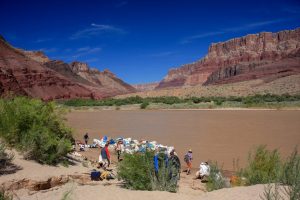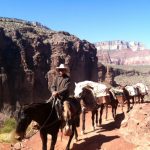On a rafting trip down the Colorado River in the Grand Canyon, there are passages of high drama and excitement around every bend: House Rock Rapid, the Roaring Twenties, Little Colorado River, Crystal, Upset Rapid, Lava Falls. These are all very famous. Every guide on the river knows about them.
Another rapid on the booming Colorado is not nearly as well known. You may float serenely past it without your guide even uttering a word about it, so small and seemingly insignificant a piece of whitewater it is when compared to Lava or Crystal or one of the other giant rapids you will encounter on this desert river that was first explored by boat, in 1869, by John Wesley Powell, a Civil War lieutenant turned geologist. On that maiden voyage Powell’s party set out with four boats, one of which was destroyed in a rapid—mirroring the fate, in a curious way, of what happened more than a century later in an incident on Randy’s Rock Rapid.
Randy’s Story
Randy’s Rock, which is a large Tapeats sandstone on the left side of the river channel, appears just past Mile 126 on the journey. No doubt Lieutenant Powell and his crew blew past it without an afterthought. It’s six miles upstream from Deubendorff, a much larger and gnarlier rapid that’s rated 9 on the scale used by Grand Canyon river-runners to measure the technical difficulty of steering a raft cleanly through a rapid without flipping it. The most fearsome rapids—Hance, for example, at Mile 77 or the epic Lava Falls farther down river—are rated 10, the highest difficulty.
Randy’s Rock Rapid, by contrast, is a measly 2, a little riffle that may not even deserve the name of rapid. But you and your guide will be making a mistake if you sweep past it on your raft without paying it the attention that it is due. For, like so many places in this vast geologic wonderland carved by eons of river flow, there’s a story behind it that’s worth hearing.
The rapid is named after a California river rat named Randy Breckenridge, a rangy six-footer with longish straight brown hair and a thoughtful but friendly disposition. He loved the outdoors as much as anyone, climbing peaks in his home range of the High Sierra and becoming a whitewater guide of verve and consummate skill. I admit to a little bias about Randy; he was a friend of mine. We climbed and rafted together, and did a little drinking and partying too, after first meeting as freshman at UCLA.
Personality-wise Randy was, to be honest, not the most reliable guy you’d want to hang with, but on a river he was steadfast and true. His resume included the biggest, most challenging whitewater in the West: the Selway, Middle Fork of the Salmon, Cataract Canyon. California’s badass Tuolumne River was a favorite of his. One spring he took me and a redheaded admirer of his—she and I were both newbies, seeing if we could learn how to run rafts and catch on as paid guides with a commercial outfitter—on a solo one-day sprint down the Tuolumne. The river was in full roar, bellowing at flood stage, producing giant churning waves and moving so fast it took your breath away. But with Randy on the oars we glided over Clavey Falls, one of the scariest drops in all of rafting, like it was a children’s water ride at Disneyland.
The Magic of the Canyon
Randy rafted the Colorado many times, both on private trips and as a guide for commercial rafting companies. People come from all around the world and pay thousands of dollars apiece—the exact cost depends on the length of the trip, whether it’s by oar or motor, and other factors—to experience the Grand Canyon in a way they would never be able to by standing on the South Rim and gazing across at the unfathomable walls or hiking thousands of feet down into the gorge via the Bright Angel Trail. Down by the river, and especially when you walk up a side canyon fed by a tributary, this arid landscape morphs into a lush tropical paradise, like you magically stepped out of Arizona and into Tahiti with its mesmerizing waterfalls and pools the color of turquoise.
The colors of the water and sky, and of the rock walls, which date back millions of years, all shift and blend according to the time of day and the changing light. One evening with the arrival of dusk we watched a sacred datura, Georgia O’Keefe’s favorite flower, unfold its curling white petals in front of our eyes. Another day a Gila monster plodded slowly but cockily through camp. We gave him a wide berth.
Those who have never been to the Grand or have only seen it from the rim may regard it as static, unchanging; it is anything but. It’s a show, a razzmatazz interactive spectacle that changes from day to day, hour to hour, even minute to minute. Time evaporates like the moisture on your skin after you take a dip in the chill waters of the river and then sit for a moment drying off on the tube of your boat. What day is it? When did we start our trip? Ordinary cares drift away as you idly drift along a stretch of green flat water.
The Canyon Turns Tough
But don’t get too comfortable; this is the desert after all. That long peaceful stretch of green can transform in a heartbeat into a big, frothing, boat-eating monster whose thundering roar announces its appearance well before you actually see it, like the T-Rex in Jurassic Park. It’s coming.
On this particular American River Touring Association trip, in which my friend would achieve a kind of immortality through an epic fail, my titular role was as an “assistant boatman,” although in reality I was merely a lucky stiff who happened to catch a free ride on a 12-day, 225-mile oar-powered raft excursion down America’s greatest river. Our three inflatable rubber snout rigs and a paddleboat were carrying about twenty people, including the guides. After a stop for lunch about halfway through the trip our boat set out on the river ahead of the others. A little ways downstream Randy, bowing to the wishes of a passenger who had been begging for a chance to row, turned the oars over to him. With the next stretch of river being mostly smooth and calm, he figured this was a time to kick back and enjoy the sun and scenery.
Bad mistake.
On the mighty Colorado, even small lapses of judgment can be punished severely if you’re not paying attention. And we weren’t. Our new boatman lost control of the raft and let it turn dangerously sideways. Before we could react it slid quickly up against the Tapeats slab and started taking on water. Lots of water, lots and lots of it, was suddenly crashing over the sides of our raft while the current sucked the bow downward. This little riffle, it turned out, had teeth. It tossed four of us—one quick-footed passenger managed to scramble up onto the rock—into the drink.
One of those who only seconds before had been relaxing in the sun was a teacher from the Midwest, a kindly older man who did not know how to swim. “Help me,” he cried in a faltering voice as the two of us cascaded down the river a few feet apart. “Help me.” Relying on my training as a summer lifeguard, I grabbed the back of his life jacket—fortunately, we were all wearing them—and kicked him to shore. I learned later that Randy did much the same thing with another passenger who was freaking in the cold, fast-running water.
Rescuing our Raft
When we all got back to the site of the crash, standing safely on shore, nobody could quite believe what their eyes were telling them. Our mangled Titanic of a raft was wrapped around the Tapeats, one half of it sticking above water and the other half pushed down under it. And the one passenger was still standing forlornly on the rock, scared out of his wits.
The head guide on our trip was Peter Winn, who had been down the Colorado numerous times. But he had never seen anything like this before. “A twenty-two foot long by nine foot wide snout with three foot diameter tubes and eight air chambers just couldn’t sink,” he wrote years later in There’s This River, a compilation of rafting stories about the Grand Canyon. “Its heavy steel frame just couldn’t turn into a pretzel in a few minutes.”
Ah, but it did, much to his chagrin and disbelief. Winn and another guide were following in the two boats behind us, and they alertly pulled to shore when they heard our warning shouts. The crushing force and relentless power of the river was continuing to push the raft further underwater, an unacceptable development if no other reason than it carried food, sleeping bags, and gear that we needed for the rest of our trip. Something had to be done to rescue it, not to mention the guy on the rock.
In a heroic effort of his own Winn caught a ride on the other raft as it slipped through the rapid, jumped into an eddy, then scrambled on top of the sandstone where he cut one of those nine-foot snouts free. Then he coaxed the shivering passenger off the rock and they made it to shore a couple of hundred yards downriver.
Etching Our Names in River Lore
That night everyone made do. We pitched camp at an improvised spot a little ways down from the wreck. Those without sleeping bags slept in blankets. The next morning, after the river dropped, the guides got out to the rock and cut the rest of the rig free. They stashed the remains in some rocks and it was picked up later. Its crushed steel frame, however, was kaput—”twisted and broken beyond hope,” in Winn’s poetic words.
Despite our difficulties our hardy band plunged on, spending five more days on the river after that. The five of us who were boatless hitched rides on the two surviving rafts and the now extremely useful paddleboat. Word about our misadventure spread like wildfire—demolishing a raft that size on the Colorado was unheard of then, and still is today—and other trips on the river pitched in with food and gear to get us through. As John Fogerty sang, people on the river, they’re just happy to give.
Following a climactic rollercoaster ride down colossal Lava Falls (one of our passengers jumped in at the top and swam it), we ended our journey at Diamond Creek after having permanently etched our names—well, Randy’s at least—in Grand Canyon river lore.
The Aftermath
Our head guide Peter Winn followed in the footsteps of John Wesley Powell and became a geologist; he has made rafting first descents of rivers in Tibet and China. Randy’s fate was more troubled. He became a photographer for a San Francisco television station. He had two fine sons but lost a baby to an early death. Divorce, drugs, and liquor overwhelmed him, much the way those walls of water crashed over us in the rapid that now bears his name. My understanding is that he died alone one night, in the cab of his truck, without ever seeing his fortieth birthday.
My daughter told me the other night from New York that she is planning a river trip down the Grand this August with friends. I will tell her what I would tell anyone who is considering a similar trip.
“Go. Do it. They say that everyone, before they die, should see Paris at least once. It’s the same, in my book, with a rafting trip down the Colorado River in the Grand Canyon. At the risk of sounding like a travel brochure, it is, no hype, the adventure of a lifetime, an experience you will remember always. And when you go be sure to give a tip of your sun hat to Randy’s Rock Rapid as you float harmlessly by.”








Wow, what a ride!
Hi Dave! It’s been 45 years since the Randy’s Rock trip and since I last saw you. Great story. I still have the original story that was published in the Springfield News-Sun by Jim Hayes in 1977, with photos and sketches.
Your article is quite helpful! I have so many questions, and you have answered many. Thank you!
I wrapped a 13’ Miwok raft on the very same spot on my first trip rowing the Canyon in 1981. We were 15 friends from Bear Valley California on an 18day private permit. I was following my friend Ric McCann (RIP), who was also a Stanislaus/Tuolumne River guide, and he said he had made the move on a previous trip and it was fun. Being a private trip, we may have had a few beers since this stretch really didn’t have many rapids of consequence….
I misjudged the entry and was swept into the rock in an instant. I highsided and my might arm became stuck temporarily between the rock and the raft and the boat wrapped on the undercut leaving only the side tube visible. My one passenger swam left through the slot and I to the left. Somehow the current surged and snapped a spare oar which in turn punctured the tube, allowing the raft to flip and float free. We pulled over and patched the raft with Barge glue and hypalon. Nothing was lost except for the pride of a rookie boatman and the broken oar.
My only GC wrap and flip all in one!